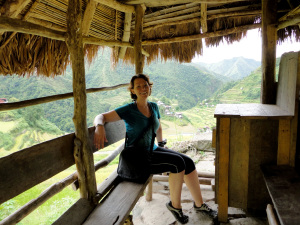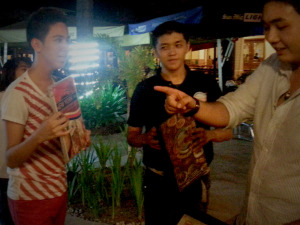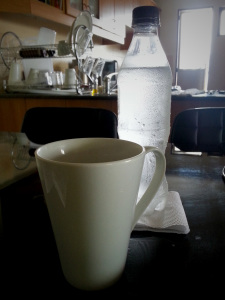EpicTrip: Philippines
June 14 – 24, 2013
You may have heard that Filipinos are some of the happiest people on earth. I believe that. My hope is that it rubbed off… sort of. More like, I hope I remember everything I learned about myself while I was there. They showed me the frequency at which I resonate.
I saw beauty, kindness, ingenuity, compassion, community, aggression, and happiness. I thought that when I left the Philippines I was leaving all of that behind, but I carry my little portion with me every day.

I need to go back, this is still true, but the urgency I felt about it has cooled.
It’s been over a year and I haven’t managed to write about it, yet. I sit quietly, reliving the experiences with a big smile and a few tears, but no words. Until now.
Please allow me to share with you my trip to the Philippines.
Most notable cultural difference
If you’re not sure what “community” means, they’ll teach you. Every person contributes to the ecosystem of the community, each finds ways to contribute to others within the community, and there’s a profound understanding that we’re all in this together.
The cab driver saves his water bottles and gives them to the street kids on the corner so they can get a little money for food.
The bus driver on long-haul trips picks up people going to/from work on our route so they don’t have to hire a car — we’re going that way anyway, right?
The street vendors are more likely to help each other than openly compete with one another. Yes, they are legitimately competing with one another for their daily earnings, but they recognize that everyone out there is doing the same thing and there’s no reason to be hostile about it.
Even if only in small doses, you will find yourself becoming part of the community.
Items of Note
- Recycling, Reducing, & Reusing Culture: You won’t find recycling bins in most places, but you will definitely see a lot of reusing items, people collecting recyclables to turn in for a little money, and people being cognizant of materials (I’m amazed at all the uses they have for plastic bags and you can build a front door out of just about anything!).
- Rubbish Mindfulness: While Manila is a very dirty, dusty city, there’s not much trash laying about (which is impressive for the most-densely-populated city on the planet). Away from the city (like, Banaue), where the populations are more sustainable, the plentiful agriculture means fewer packaged goods and a lot less rubbish.
- Ease of Walking (space, crosswalks, hills / steps, etc.): It’s amazing how quickly one gets used to walking among traffic. Lanes are an interesting suggestion, and sometimes, you’ll see a bus execute a bus stop from the middle lane. That’s right: people getting on and off the bus while dodging traffic… and it is fluid, calm, beautiful. The safest way to cross the larger streets is to use one of the elevated crosswalks. Sidewalks may be present, but you’ll usually have vendors or taxi bikes parked on them, so walking in the road is pretty common.
- Ease of Public Transport (bus, train, taxi, ferry, etc.): Surprisingly easy, but there are a lot of unscrupulous cabbies. If you can call a car service, do that. The bus terminals that do longer-haul trips tend to be nowhere near wherever you are, and you have to make your purchases in-person, so build in some extra time to go get your ticket early (because they generally sell out). Do this early in the trip, too — best advice I received before my trip was “don’t stay too long in Manila. 2 days, tops, then get out of the city.”
- Politeness of Traffic: While riding in a van, we nearly ran over an old man. Close-calls happen all the time, but rarely is there a real “we’re going to hit this person” moment. The reaction of our driver was to roll down his window and express that he hadn’t intended to get so close. The old man apologized for being so slow, then they had a laugh before we drove away. Driving is aggressive but not hostile. While there are parts of town where this is less-true, in general, this is a pretty good description of things around here: aggressive but not hostile, and usually jovial.
- Graciousness of Service Personnel: You’re likely to get a little dance from whomever is serving you — not a performance, but just a little bit of glee escaping through the toes and a smile. A large portion of the people in Manila speak English — and very well, I might add — so, you’ll be able to interact in a familiar language, but endeavor to learn a few words like hello and thank you. Your effort is both appreciated and rewarded.
- Connectivity (Internet / Cell): Cell is fine, Internet is real spotty in Manila. Most places aren’t hard-wired for data, so people use pre-paid wifi fobs… but when you have over 1.5 million people in less than 15 square miles, all those wifi fobs start to get in each other’s way. Best wifi signal: the hostel in Banaue, up in the mountains, far away from everything.
- Public Events: Not sure about public events, but entertainment is plentiful! Some venues have a single stage, a bunch of tables in the middle, then 4-6 bars and restaurants serving the area — so each patron gets swarmed by servers from the different restaurants as they enter, then you sit wherever you want and they keep track of who’s serving whom. Definitely catch a show or seven — the talent is amazing. (I believe my words were, “Maria Carey would be considered a no-talent hack over here…”)

Choosing our server
- Operating Schedules (Restaurants, Shops, etc.): I don’t recall going somewhere only to find it closed. No idea what the hours were, but they were always open when I needed them. The only exceptions that come to mind are places that require a little more hand-holding (like places that provide tours or that are far away from where you’re staying) — they’ll have limited access schedules and try to get you out of there with enough time to make it home before dark.
- Weather Preparedness / Accommodations (Homes & Public Areas): It’s hot. I happen to enjoy the weather in the Philippines. Most places have open doors and windows with ample fans to keep the air moving (this is the hardest part about the heat in Manila — if the air gets still, it’s brutal). The enclosed spaces with A/C will freeze the sweat you brought with you — it’s a little drastic. There aren’t a lot of places with A/C unless you hit the touristy areas — hotels, casinos, fast food, the Mall of Asia (which, oddly enough, is only partially enclosed and air conditioned), and the buses (oh-holy-coldness, the buses). Most restaurants, transportation, and even museums are simply open-aired with fans.
- Variety / Quality of Foods: There is more variety in both the types and qualities of food available than even remotely expected — mostly because I ate in Manila and in towns well outside of the city. If you want fast food and things that are familiar, you can get that… but the Japanese restaurant we visited and the street vendors — while drastically different qualities of food — were amazing and both worth the adventure. When having street vendor food, commit to the experience and don’t ask too many questions. If it smells good, try it. In hindsight, I know what I ate, but I don’t care — they’re magicians and it was fabulous.
- Incorporation / Respect for Indigenous Peoples: Not terribly applicable here. The indigenous people are all around, it’s the invaders who keep coming/going.
- Pet Culture: I didn’t notice any “pets,” per se, but there were quite a few “four-legged neighborhood residents” that everyone took care of. Cats and dogs, mostly. They weren’t clean or fat, but they were healthy and very docile. Afternoon nap-time is the best time to spy the local furry inhabitants.
- Preservation Culture: This varies greatly depending on where you are. In Manila, it’s more about survival and co-existing; in the mountains, it’s about living harmoniously among, for, and at the mercy of your environment. This is one of the most fertile places I’ve seen, so the only areas where preservation would be a consideration are areas where there are simply too many people for the resources.
- Public Access to Amenities (Coasts / Beaches, etc.): there’s plenty of access, but not enough mobility for those who can’t afford it. Getting to and from somewhere within a day is a luxury, so accessing available amenities — regardless of their availability — becomes a luxury, too.
- Spacial Awareness: There is very little personal space in Manila, but people are also cognizant of how much space they take up and aren’t going to get into yours unless they must. Even in the extremely crowded markets, people don’t bump into each other. The personal bubble is very small, but it’s still there. Watching people move about is fascinating — I’ve never seen scads of people who move and react more like schools of fish. Walking, driving, they are fluid, don’t take up more space than they need, and know exactly how much space they need to maneuver — reacting to each other, flowing around obstacles. Things like this look chaotic on tv, but being in the middle of it, you can feel how well it moves. Most side streets are legitimately one-lane streets with cars and trikes parking on the sides. I’m still amazed at how, even with pedestrians everywhere, these are used as two-way streets, and everybody gets where they are going. (If you get the chance to see a driver turn their bus around in a car-sized parking spot — on a cliff-side road, that’s a real treat.)
- Coffee Culture: In Manila, it’s instant coffee all the way. You can get a small jar of coffee granules if you go to one of the larger markets, but you’re most likely going to find the single-serve packets, and they’re numbered: black coffee is #1, black coffee with sugar is #2, and coffee with cream and sugar is #3. If you can’t read the rest of the package, the number will tell you what it is. Outside of the city, however, the hot, freshly brewed, locally grown coffee is glorious.

Everything sweats. Still drinking hot coffee.
- Wine & Beer Culture: Beer and liquor aren’t hard to come by (nor are they expensive), but you’re less likely to see wine. Like coffee, you have decent options at the larger stores, but you’ll mostly select from what’s available at the corner store, a restaurant, or a casino. In a few spots outside of Manila, a wine made from local fruits is available, but it’s on the sweet-side, so I can’t try it. One of the local beers, San Miguel, is widely available and rather delightful (there are a few versions to choose from) — oh yes, and legal drinking age is 18.
- Cell Phone / Personal Entertainment Culture: Cell phones are common, but there may only be one to share between a few people — many of the homes, especially in the poorer neighborhoods, don’t have the infrastructure for land-lines, so a household will usually have a cell phone. It will also likely be a standard cell phone with a camera, not a smartphone — the data charges for smartphones are high and the operating systems use a lot of power, so a standard cell phone is preferable.
- Smoking Culture: Yes. Just yes. While smoking is kept outdoors, you’re outside most of the time, so you’ll be around it quite a bit. However, since you’re outside, it’s really not that bad and dissipates pretty quickly.
What I Learned
I can, at times, if I want to, mimic extroversion… but I’m an introvert. I’ve always been good with this, but honestly — given the environment I’ve grown up in and currently live in — I had grown to feel like I was copping out (or something similar) whenever I embraced and nurtured my personal time.
Something beautiful happens when you find the pace at which you move well, the frequency at which you operate best, and the stillness that lets your mind get clear on things. It’s not always easy to stay in this place. I’ll veer a little too far in one direction… then correct course. I’ll move too quickly, or not quickly enough… then correct. I’ll neglect my peace, wonder why I feel hectic,… and correct again. I won’t always get it right, but I’m a lot better at getting close.
As such, I say “no” a lot more frequently than I used to. Or rather, I say it without excuses or guilt. And I only say “yes” to the things that feel right to me. I like this place and I’m going to live here as much as possible.
This is the “Pick your Adventure” part of the post.
Follow these links to the adventure stories you want to read!
- Adventure: Over Dinner
- Adventure: Mall of Asia & the Casino
- Adventure: The Divisolia Market (& the ER)
- Adventure: Banaue
- Adventure: The Ifugao Tribe
- Adventure: Rice Terraces of Batad << Personal Favorite!
- Adventure: Villa Escudero
For a while now, I’ve joked about needing to live “on the equator.” I still say that, but with a twinge more sincerity.
I also try not to quote Arnold Schwarzenegger too often, but… I’ll be back.